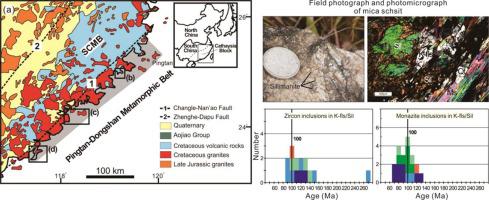Journal of Asian Earth Sciences ( IF 2.7 ) Pub Date : 2021-07-09 , DOI: 10.1016/j.jseaes.2021.104891 Jian-Wei Lin, Chi-Yu Lee, Cheng-Hong Chen, Takenori Kato, Yuji Sano, Takahata Naoto

|
Detailed age information of the Pingtan-Dongshan Metamorphic Belt in the coastal Cathaysia Block is important in understanding geodynamics of the Late Mesozoic South China continental margin. Geochronological determinations on monazite and zircon inclusions and zircon separates from five mica schists and two granites intruding schists are used to constrain the timing of metamorphism and sediment sources. Common ages of monazite and zircon inclusions within major constituents (quartz, muscovite, sillimanite and K-feldspar) in schists define a high temperature/low pressure metamorphic event at ~100 Ma. Along with zircon ages of granites (106 and 101 Ma), a Buchan type metamorphism is proposed regarding a heat source from the post-orogenic magmatism in the neighboring igneous province. Based on the age distribution patterns of discrete zircons, two groups of schist are distinguished by sources of sediments prior to metamorphism. One group has a simple age cluster (145–130 Ma) inferring proximal magmatic rocks in the Cathaysia Block. The other group shows a widespread age spectrum with two particular populations of ~1.8 Ga and ~190 Ma that are uncommon in the Cathaysia Block but comparable to schists in the Tailuko Metamorphic Belt of eastern Taiwan. This may suggest a general source between these two belts in which a now-concealed microcontinent would play a role. Such a new tectonic framework can account for the two provenances of sediments in schists of this belt, and its structural configuration is influenced by a high temperature regime caused by mantle upwelling as a reflection of slab rollback of the subducted Paleo-Pacific Plate during 110–90 Ma.










































 京公网安备 11010802027423号
京公网安备 11010802027423号